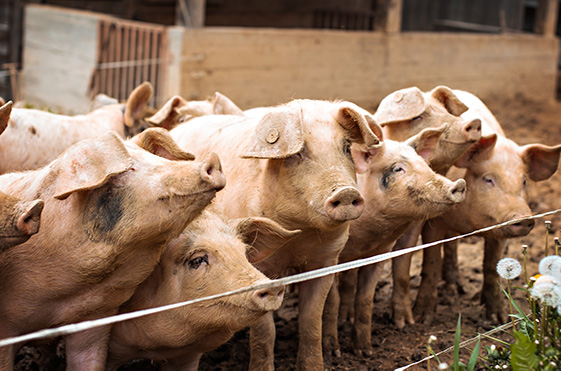Land
A molecular diagnostic test for Chlamydia gallinacea
Chlamydia gallinacea is a poultry-associated strain of Chlamydia associated with reduced weight gain, and its status within Australia has yet to be investigated
AusGEM is developing a molecular diagnostic test for C. gallinacea. This test will allow discrimination from another avian strain, Chlamydia psittaci and determine the prevalence of C. gallinacea in NSW poultry.
EMAI’s extensive sample bank will be utilised, including faecal samples, cloacal swabs and DNA extracts recently collected during the Salmonella Enteritidis response and a disease investigation in turkeys. Positive samples will be subjected to OmpA gene sequencing to allow characterisation of Australian strains compared to international strains, and to determine whether strains display host specificity (i.e.: chicken strains versus turkey strains).
AusGEM will perform whole-genome sequencing on selected strains if practicable, based on the load of C. gallinacea within samples, enabling genome-wide comparisons of strains.
Proof of Concept Study: using Agriseq panels for grain biosecurity diagnostics
AusGEM is undertaking a proof-of-concept study that combines diagnostics for endemic diseases and exotic diseases of biosecurity concern through the development, testing and potential use of Agriseq panels to support diagnostics for plant industries in NSW and Australia.
AusGEM researchers, in conjunction with commercial collaborators, will work towards the developing an Agriseq panel for the Australian grains industry and will test it on field collected samples from the NSW wheat belt.
Wheat diseases will be the focus of this proof of concept study and, if successful, there is potential to develop Agriseq panels for all major plant industries for Australia. This will have a significant industry impact, especially by strengthening Australia’s market access position. Agriseq panels could enable the NSW grains industry to not only have rapid molecular diagnostics but have added market access support through incorporating markers for exotic pathogens to provide evidence of absence. This research has the potential to strengthen Australia’s capacity to detect and respond to new incursions before they become widespread and established in Australia.



Genotyping assays to understand the genetics of Yellow Crazy Ant incursions
Yellow Crazy Ants (Anoplolepis gracilipes; YCA) are among the worst invasive species globally and are classified as Prohibited Matter under the federal Biosecurity Act 2015. Their rapid ability to form super-colonies has devastated ecosystems on every continent with their propensity to prey on and displace indigenous invertebrates that are crucial to biodiversity and ecosystem health. YCA also form mutualistic relationships with horticultural pests such as aphids, protecting them from predators, which increases their threat to the agricultural industries.
Several incursions of YCA have been reported in northern Australia since 1980 and since 2018, NSW DPI and Local Land Services have been responding to an infestation in the Lismore region. Data from surveillance of the Lismore incursion support that it is restricted to 2 sites: Lismore CBD and Terania Creek. Anecdotal evidence suggests that these 2 infected sites are linked to a single incursion, but the origin of the original incursion is unknown.
AusGEM aims to develop genotyping assays that are suitable for understanding the population genetics of the YCA incursion(s) in Lismore. These genotyping assays will be developed to allow cooperation and collaboration from other organisations, both national and international. DNA from other YCA incursions across Australia will be accessed, to build knowledge about any relationships between incursions.
The findings of this research will potentially form the basis to share and build genetic information globally to support the management of YCA incursions.
Using genomics to understand honeybee brood disease outbreaks
AusGEM is undertaking one of the largest efforts internationally to sequence bee pathogens.
As pollinators of crop and fruit monocultures internationally, managed honeybees are universally considered one of the most important production animals and in Australia, bacterial bee diseases are a major threat to apiculture. Among the bee diseases endemic to Australia are the American foulbrood (caused by the bacteria Paenibacillus larvae; AFB) and European foulbrood (caused by Melissococcus plutonius with Paenibacillus alvei a common secondary invader; EFB). Both AFB and EFB cause significant honey production losses, greatly affect the health of hives and are notifiable diseases in Australia.
AFB is particularly devastating and difficult to manage, given its lethality to bee larvae, being highly contagious and forming extremely tenacious endospores that can remain infectious for decades and withstand extreme variations in temperature and humidity. Despite efforts to eradicate the disease, AFB detections in Australia appear to be increasing, and recent positive detections have threatened the honey export industry.
AusGEM researchers will sequence isolates of P. larvae, M. plutonius and P. alvei from isolates at EMAI, using short-read sequencing technology, providing a significant boost to the research of AFB and EFB. Additionally, Ausgem scientists plan to sequence representative isolates using the MinION platform to produce high-quality reference sequences of each pathogen and examine mobile genetic elements.
The results will be used to develop WGS-based schemes for epidemiological tracing, evaluate typing tools for use in future brood disease outbreaks and support functional genetic research of these diseases.
Developing a food authentication tool: Australian honey as a proof of concept study
AusGEM researchers are undertaking a proof-of-concept study using Australian Leptospermum (commonly known as manuka) honey as a first step towards the development of a food authentication tool.
Recent reports suggest that nearly 20% of Australian honey is adulterated with cheaper substitutes and that the floral and geographical origins of the honey are often mislabelled, negatively impacting consumer confidence in Australian honey products. This data also demonstrates that the apiary industry critically needs an accurate and rigorous test to authenticate the floral source of their products. This is particularly relevant for premium honeys which have known bioactive and medicinal properties. Australia has over 80 native Leptospermum species, many of which produce honey that is as equally bioactive as its better known New Zealand manuka counterparts. Therefore, there is great potential for Australia to make a considerable impact on the international market, valued at around $1billion annually. An accurate and rigorous test to guarantee floral source would help to boost the Australian influence in this market.
Current tests for honey authenticity, which use chemical marker panels, sometimes fail to authenticate honey accurately as the chemicals are readily influenced by beekeeping practices, changing environments and different processing conditions. AusGEM research will be among the first to investigate the use of genetic markers, that originate from the genome of the honey’s floral source, for honey authentication.
AusGEM will focus on developing a test to effectively and specifically determine the floral, and potentially the geographical origins of Australian Leptospermum honey. The potential of identifying these genetic markers is vast, as this test could be adapted not only to be specific to other honey types but other natural high-value foods that face similar adulteration issues, such as olive oil and wagyu beef. The development of a food authentication tool has the potential to increase consumer confidence and safety and preventing further economic losses. This tool could also be developed into a national standard to support the Australian honey and beekeeping industries.


Towards Rapid, Point of Care Detection for Bovine Mastitis: a proof-of-concept study
Mastitis is an inflammatory condition of the bovine mammary gland that the major cause of poor udder health in cows, costing Australian dairy farmers more than $150 million each year.
Subclinical mastitis is a silent disease contributing to increased bulk milk (somatic) cell counts (BMCC), ultimately reducing milk quality and compromising payment incentives for low BMCCs. Subclinical mastitis is not easily detected and requires costly, time-consuming and labour-intensive diagnostic tools. Mastitis pathogen identification is delayed due to the requirement for culture in the laboratory, so empirical antibiotic treatment is common. Therefore, pathogen identification is frequently not performed for mastitis cases, and there is significant potential for antimicrobial resistance to emerge.
AusGEM is addressing the significant need for a rapid, robust field test that can identify earlier onset of mastitis and guide better case management to considerably reduce the costs associated with subclinical and clinical disease.
Researchers will sequence circulating populations of immune cells within blood and milk as a proof-of-concept to identify transcriptional profiles that can be used to identify putative biomarkers as the basis for a rapid, point-of-care device to enable much earlier intervention of mastitis cases. This approach to differentiate multidrug-resistant (MDR) from non-MDR pathogens affecting cattle, has the potential to greatly improve MDR management and decrease inappropriate antibiotic usage. In addition, this host-centred, genome-scale approach to understand infections will further benefit Australian industry, as this can be applied to any primary industry-relevant animal with an immune system.
Using metagenomics to investigate viral diseases– Bovine respiratory disease as a model
AusGEM researchers are using metagenomics to investigate bovine respiratory disease (BRD), an infectious disease that is the leading cause of illness and death in Australian feedlot cattle.
BRD in feedlot cattle is caused by a combination of stress, infectious agents and bringing together young animals from different farms. It is usually not one single pathogen that causes BRD, but rather an interaction of a complex and variable mix of viral and bacterial agents. Viruses tend to predispose to bacterial infections. BRD is thus caused by a diversity of pathogens, referred to as Bovine Respiratory Complex. Five viral pathogens are traditionally known to be associated with BRD both in Australia and globally. However, recent metagenomics tools have revealed the presence of additional viral species, that are not commonly tested for in veterinary diagnostic labs.
Sequencing of the complete virome (all viral species present in a sample) can be achieve by using next-generation-sequencing metagenomics.
AusGEM’s pilot study will see protocols developed and validated to undertake NGS on different sample specimens from both live and deceased animals. The successful development of this approach will enable this tool to be used for investigation of complex or emerging diseases in all animal species and improve infectious disease diagnostics. This research will also generate essential data and analyses to understand the viruses that cause BRD in Australia.

Comparative Genomics of the fungal pathogen Alternaria
AusGEM researchers are working to identify and characterise different species of Alternaria, a fungus that is consistently identified as a cause of disease in Brassicaceae vegetable crops. Infections are most commonly caused by Alternaria brassicae and A. brassicicola species, and by A. alternata. In NSW, field surveillance has revealed the presence of the fungal pathogen Alternaria infecting Brassicaceae crops, such as cauliflower and broccoli.
Scientists will undertake genome sequencing and comparative genomic analyses, which will help inform growers which Alternaria species are present in vegetable crops. The process of genome sequencing and performing these bioinformatics analyses will also help build biosecurity capacity for fungal pathogens.
AusGEM’s work provides several potential benefits including increasing agricultural productivity, as an understanding of the pathogen can be utilised for disease tracking, decisions in disease management practices and identification of exotic incursions. Preparation of these genomes also provide future opportunities in diagnostic development by identifying unique regions of the Alternaria genome for targeted diagnostics.
Using molecular epidemiology to investigate the origins of the Bluetongue virus in livestock
AusGEM is tackling the global problem of bluetongue virus (BTV), a non-contagious, insect-borne, viral disease of livestock. BTV is transmitted by biting midges and it can cause severe disease in sheep and variable disease in other ruminants and camelids, depending on the serotype. Although infection in cattle is subclinical, cattle play a major epidemiological role as a reservoir of the virus. The World Organisation for Animal Health has traditionally listed BTV as a highly important transmissible disease due to its potential fast spread and devastating socio-economic consequences. This list includes other devastating diseases such as Foot-and-mouth disease, African Swine Fever or Avian Influenza. The presence of this virus in a territory imposes international trade restrictions on live animals and animal products.
BTV is a notifiable endemic disease in Australia, and only a few out of the 28 known serotypes are present in the country. BTV serotype 1 and 21 are usually expected in NSW, however, recent National Arbovirus Monitoring Program (NAMP) data from NSW and southern Queensland detected the incursion and rapid spread of serotype BTV-16 along the eastern seaboard in 2017 and 2019. BTV-16 caused a 2002 disease outbreak in sheep in the Northern Territory so the spread of BTV-16 from Far North Queensland into northern NSW, within a few months, is concerning both from an animal health and trade perspective.
AusGEM researchers are working to identify the origins of new serotypes of BTV in NSW and to identify whether BTVs in NSW are part of a spectrum linked to the virus population of Northern Australia or have evolved locally in NSW. The characterization of these new viruses is important to understand the current genetic diversity and to monitor virus evolution, especially as reassortment of the segmented genomes of BTVs is a frequent event. Using blood samples from both a large archival collection and recently collected samples, the full genome of BTVs will be sequenced. Further, AusGEM scientists are developing methods that will allow the sequencing of BTVs directly from blood samples and insect collections, thus avoiding potential genetic changes induced by passaging of viruses in cell culture.
The molecular epidemiology of BTV in Eastern Australia will be described, by comparing the sequence data of new and historical strains of BTV and undertaking phylogenetic studies, providing insights into the origins of these new strains and potential insights into elements that influence virus virulence. Ultimately these results may contribute to new disease alert systems and the development of disease control strategies.
Protecting cattle against international parasite
AusGEM is leading work towards the development of a vaccine for the emerging parasitic disease Bovine anemia and Theileriosis orientalis group (BATOG).
First detected on the NSW mid-north coast in 2006, BATOG already costs the NSW cattle industry an estimated $20 million each year and that cost is expected to increase substantially. In Japan, where it is well established, the annual cost is $100 million.
The Ikeda variant of Theileria, which is spread by common ticks and infects and kills the red blood cells of cattle, is related to the same microscopic parasite that causes malaria in humans. In affected cattle, it causes anaemia, weakness, abortions, reduced milk production and death.
In its work towards a vaccine, AusGEM researchers have sequenced 16 Ikeda genomes and created a system to be able to analyse the genetic diversity of the theileriosis parasites.
The outcomes of this work can be viewed in publications #24 and #48.


An effective vaccine for endemic pig pneumonia
The widespread chronic dry cough and slow growth caused by swine pneumonia, a worldwide problem for the pork industry, could soon be eliminated thanks to AusGEM research.Vaccines that exist for the Mycoplasma hyopneumoniae bacteria that cause pneumonia in pigs, reduce symptoms, but do not prevent infection, so farmers still need to rely on the extended use of antibiotics in many commercial herds for prevention and treatment of disease.
However, AusGEM analysis of the broken proteins produced by Mycoplasma hyopneumoniae has pointed towards previously unexplored avenues for the development of a more effective vaccine.
By reducing the need for use of preventative antibiotics in pig herds and improving the health of herds across NSW, the work is likely to substantially improve the bottom line for the state’s $260 million-plus pork industry.
The outcomes of this work can be viewed in publications #4, #6, #8, #19, #20, #28, #31, #37, #39, #46, #49, #52, #63 and #87.
The transmission of disease between animals and humans
It’s estimated that 6 out of 10 known human infections began in animals and three-quarters of all new human diseases are zoonotic, meaning they can cross over between animals and humans.
AusGEM scientists are now investigating the link between Escherichia coli bacteria, which are responsible for most human urinary tract infections (UTIs), sepsis and meningitis, extra-intestinal pathogenic E.coli, and pigs and chickens. Genomic surveillance by AusGEM – that includes full genome sequences for more than 1000 E. coli – has already identified strong similarities between the E. coli isolated from people treated in hospital for sepsis and the E. coli found within pork and poultry. It suggests that, rather than UTIs always being infections picked up from the bacteria in people’s faeces, as commonly thought, people may also acquire the infection through their food.
With 60% of women expected to experience a UTI infection at least once in their life, annual global treatments costs reach billions of dollars. The AusGEM discoveries are helping to shed more light on why infection rates may be so high and could lead to new techniques to prevent the infection crossing from farm animals to humans.
The outcomes of this work can be viewed in publications #50, #54, #55, #57, #64, #66, #77 and #85.

Rapid diagnosis and more effective disease treatment for fruit and vegetable crops
Genomic analysis and identification of the common bacterial plant infection Xanthomonas will enable earlier diagnosis that facilitates more effective management of this potentially devastating disease.
Varieties of the Xanthomonas bacteria afflict more than 400 plant types and are responsible for citrus canker, black rot in cabbage, bacterial blight of hazelnuts, bacterial leaf spot of pumpkins and squash, black spot on mangoes and black chaff in wheat.
The Xanthomonas collection held by NSW DPI’s Plant Pathology and Mycology Herbarium is a valuable resource to allow accurate identification of the genomic diversity of these pathogens. This information is being used to develop quick turnaround diagnostics, a project funded through the Plant Biosecurity CRC with additional support from AusGEM.
Genomic sequencing of the NSW DPI’s entire Xanthomonas collection (1000 samples) has already been completed and the team has developed a diagnostic assay for Xanthomonas citri subsp citri.
